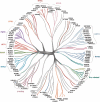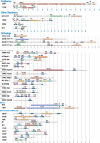The protist, Monosiga brevicollis, has a tyrosine kinase signaling network more elaborate and diverse than found in any known metazoan
- PMID: 18621719
- PMCID: PMC2453073
- DOI: 10.1073/pnas.0801314105
The protist, Monosiga brevicollis, has a tyrosine kinase signaling network more elaborate and diverse than found in any known metazoan
Abstract
Tyrosine kinase signaling has long been considered a hallmark of intercellular communication, unique to multicellular animals. Our genomic analysis of the unicellular choanoflagellate Monosiga brevicollis discovers a remarkable count of 128 tyrosine kinases, 38 tyrosine phosphatases, and 123 phosphotyrosine (pTyr)-binding SH2 proteins, all higher counts than seen in any metazoan. This elaborate signaling network shows little orthology to metazoan counterparts yet displays many innovations reminiscent of metazoans. These include extracellular domains structurally related to those of metazoan receptor kinases, alternative methods for membrane anchoring and phosphotyrosine interaction in cytoplasmic kinases, and domain combinations that link kinases to small GTPase signaling and transcription. These proteins also display a wealth of combinations of known signaling domains. This uniquely divergent and elaborate signaling network illuminates the early evolution of pTyr signaling, explores innovative ways to traverse the cellular signaling circuitry, and shows extensive convergent evolution, highlighting pervasive constraints on pTyr signaling.
Conflict of interest statement
The authors declare no conflict of interest.
Figures




Comment in
-
Clues to the evolution of complex signaling machinery.Proc Natl Acad Sci U S A. 2008 Jul 15;105(28):9453-4. doi: 10.1073/pnas.0804669105. Epub 2008 Jul 10. Proc Natl Acad Sci U S A. 2008. PMID: 18621723 Free PMC article. Review. No abstract available.
References
Publication types
MeSH terms
Substances
Grants and funding
LinkOut - more resources
Full Text Sources

